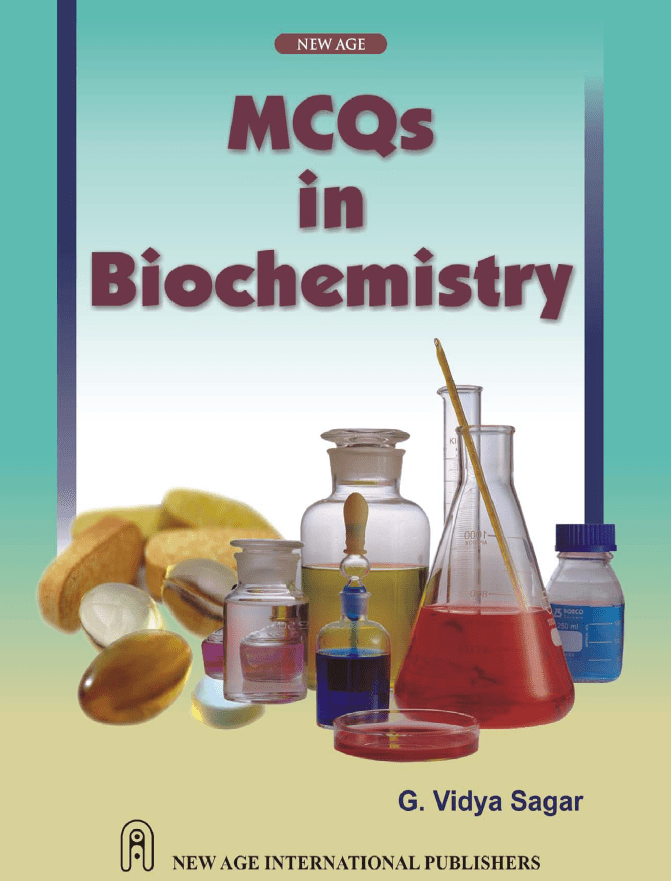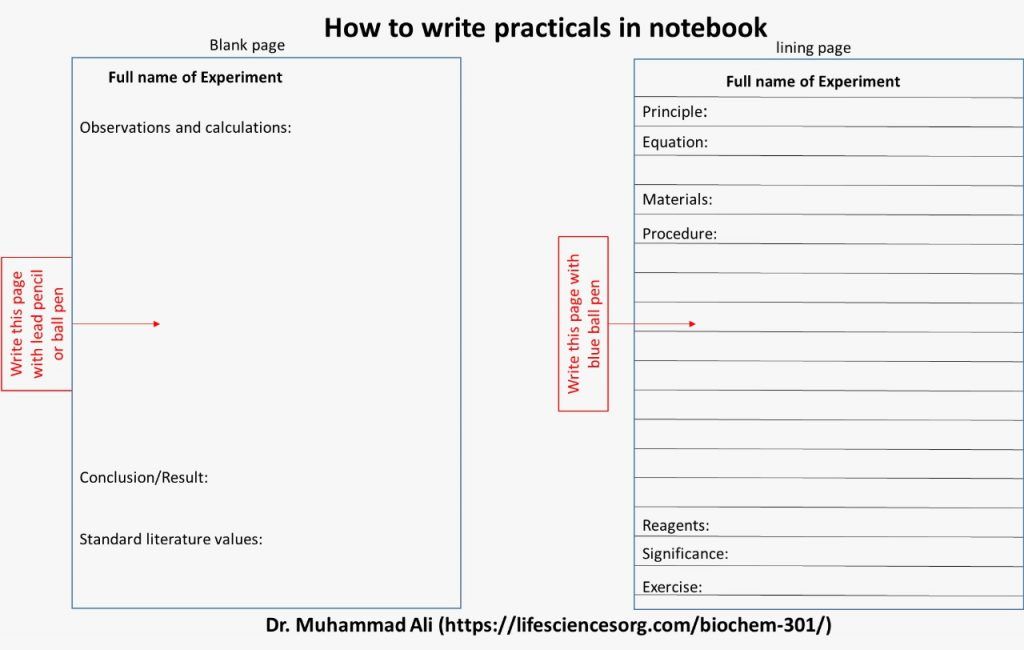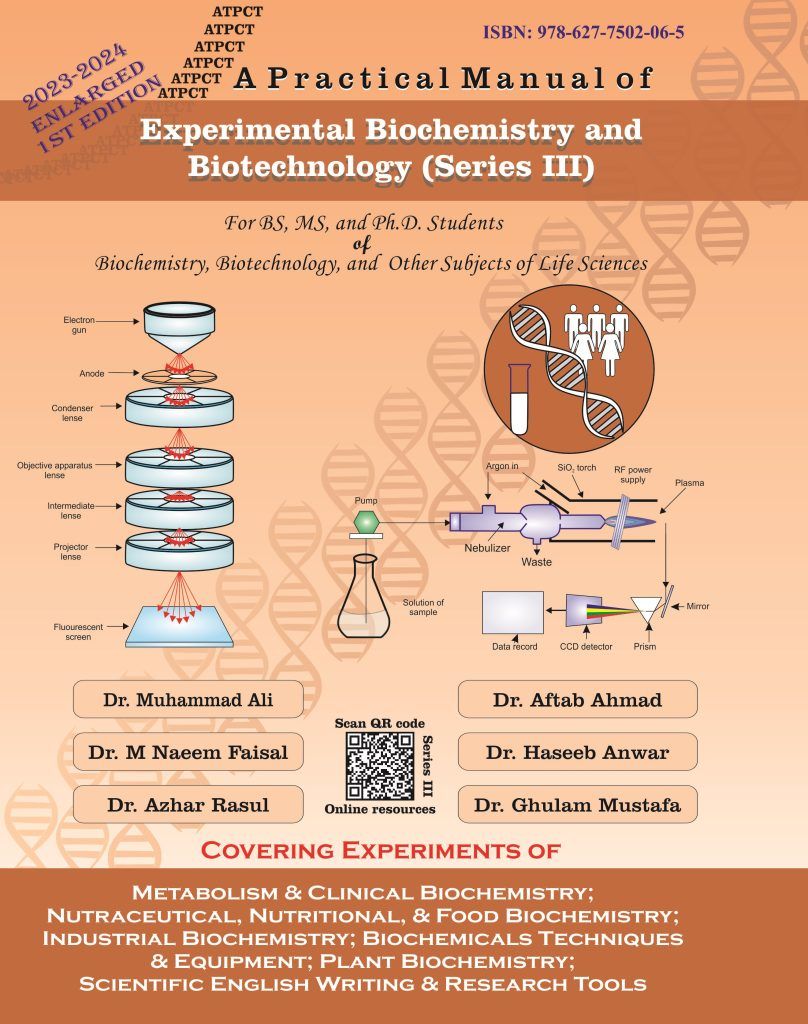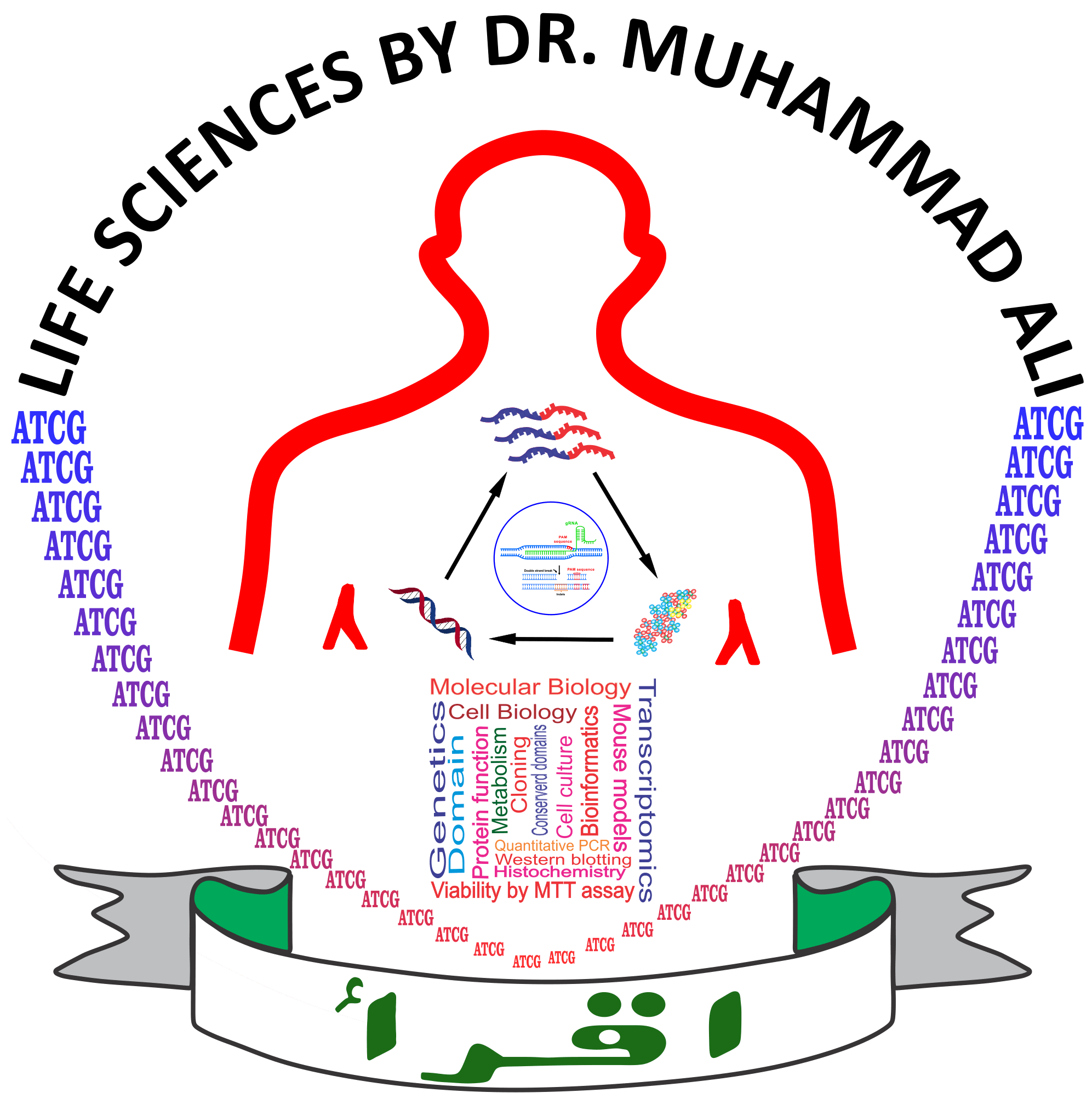Biochem-305 (list of practical)
- Estimation of glucose,
- total proteins and albumin by spectrophotometer,
- serum minerals,
- lipid profile (total lipids, triglycerides, total cholesterol, HDL cholesterol, etc).
- Clinical enzyme: Alanine amino transferase (ALT), aspartate aminotransferase (AST),
- lactate dehydrogenase (LDH),
- creatine kinase (CK),
- alkaline phosphatase.
- Estimation of vitamin A and C.
- Ali, M. et al., Experimental Biochemistry and Biotechnology (Series III), 2023, 1st edition, ISBN: 978-969-23317-6-0 4
Mid-term syllabus of Biochem-305:
1.METABOLIC FATE OF BIOMOLECULES (Anabolism and Catabolism):
Carbohydrates: Brief introduction to the digestion and absorption of carbohydrates, Aerobic and anaerobic breakdown of Glucose, Glycolysis, Pentose Phosphate Pathway, Glycogenolysis, Glycogenesis, Gluconeogenesis, Citric acid cycle, Energetics of various metabolic processes.
Lipids: Brief introduction to the digestion and absorption of lipids, Oxidation of fatty acids through β-oxidation, Biosynthesis of fatty acids, neutral lipids and cholesterol.
Proteins and Amino acids: Brief introduction to the digestion and absorption of proteins and amino acids, Metabolism of essential and non-essential amino acids, Biosynthesis and catabolism of Haemins and porphyrin compounds.
Bioenergetics: Principles of bioenergetics, Electron transport chain and oxidative phosphorylation.
Final exam syllabus of Biochem-305:
- REGULATION OF METABOLIC PROCESSES: Role of Vitamins: Physiological role of Fat-soluble (A, D, E and K) and Water-soluble (Thiamine, Riboflavin, Pantothenic acid, Niacin, Pyridoxal phosphate, Biotin, Folic acid, Cyanocobalamin-members of B-complex family and Ascorbic acid), Coenzymes and their role in the regulation of metabolic processes. Receptor Mediated regulation (Hormones): Mechanism of action of hormones, Physiological roles of various hormones, Site of synthesis and target sites of hormones. Secondary Messengers: Role of cAMP, Calcium ions and phosphoinositol in the regulation of metabolic processes. Gene Expression: Replication, Transcription and Translation (Gene expression) Introduction to Biotechnology and Genetic Engineering, Basic principles of Recombinant DNA technology, Pharmaceutical applications, Balance of Catabolic, Anabolic and amphibolic processes in human metabolism, Acid-Base and Electrolyte Balance in Human body.
- INTRODUCTION TO CLINICAL CHEMISTRY:
Introduction and importance of the clinical chemistry. Laboratory tests in diagnosis of diseases including Uric acid, Cholesterol, Bilirubin and Creatinine.
Biochem-305: Start preparing your presentations and assignments….. Assignment submission is the second week of next month, October 2022. The presentations will also be started after mid-term exam.
Presentations of Biochem-305:
- The weightage of the assignment and presentation will be decided later.
- Start preparing your presentations……
- The presentations will also be started right after the mid-term exam.
- PPT file should not contain any designing/colours other than figures and diagrams.
- Slides should be in 16X9 ratio.
- Fonts of all header should be same and of all other text should be same.
- For detailed guidelines about the presentation of research article, visit: https://www.lifesciencesorg.combiochem-720/
- Download the template ppt file to make your presentation. The link is here (copy this link and paste in a new tab).
Some important questions to be asked from students during presentation
- 1) Pathway or importance of gene/technology/drug
- 2) Rationale (justification of the project in this paper)
- 3) Conclusion of every figure
- 4) Conclusion of full article
- 5) New findings present in the article
- 6) Applications of the finding/s.
- 7) Future prospective
- 8) Principle of every technique used in the research article
NO EXCUSE WILL BE ACCEPTED
BIOCHEM-305-MA-CABB, Plant Pathology (BLT-MA)
Tuesday: 8:50-9:40; Wednesday: 8:50-10:30
__________________________________________________________________________________
Meeting ID: 316 824 288 013
Passcode: WNyjeA
Microsoft teams will be used whenever online classes will be held. You must make your first name as your registration number.
2017-ag-9382 Haidar Iftikhar
2017-ag-10077 Ahmad Faraz
__________________________________________________________________________________
Link to download the book ( MCQs in Biochemistry) is given below:
https://b-ok.cc/dl/1055171/2292c5

Biochem-305 Pharmaceutical Chemistry II B 4(3-1)
Course Learning Outcomes
To understand the metabolic pathways and their bioenergetics, their catalysis by enzymes and regulation by different types of hormones and clinical importance of biochemical analysis in diagnosis of different diseases
Theory
1.METABOLIC FATE OF BIOMOLECULES (Anabolism and Catabolism):
Carbohydrates: Brief introduction to the digestion and absorption of carbohydrates, Aerobicand anaerobic breakdown of Glucose, Glycolysis, Pentose Phosphate Pathway, Glycogenolysis, Glycogenesis, Gluconeogenesis, Citric acid cycle, Energetics of various metabolic processes.
Lipids: Brief introduction to the digestion and absorption of lipids, Oxidation of fatty acids through β-oxidation, Biosynthesis of fatty acids, neutral lipids and cholesterol.
Proteins and Amino acids: Brief introduction to the digestion and absorption of proteins and amino acids, Metabolism of essential and non-essential amino acids, Biosynthesis and catabolism of Haemins and porphyrin compounds.
Bioenergetics: Principles of bioenergetics, Electron transport chain and oxidative phosphorylation.
2. REGULATION OF METABOLIC PROCESSES:
Role of Vitamins: Physiological role of Fat-soluble (A, D, E and K) and Water-soluble (Thiamine, Riboflavin, Pantothenic acid, Niacin, Pyridoxal phosphate, Biotin, Folic acid, Cyanocobalamin-members of B-complex family and Ascorbic acid), Coenzymes and their role in the regulation of metabolic processes. Receptor Mediated regulation (Hormones): Mechanism of action of hormones, Physiological
roles of various hormones, Site of synthesis and target sites of hormones. Secondary Messengers: Role of cAMP, Calcium ions and phosphoinositol in the regulation of metabolic processes. Gene Expression: Replication, Transcription and Translation (Gene expression) Introduction to Biotechnology and Genetic Engineering, Basic principles of Recombinant DNA technology, Pharmaceutical applications, Balance of Catabolic, Anabolic and amphibolic processes in human metabolism, Acid-Base and Electrolyte Balance in Human body.
3. INTRODUCTION TO CLINICAL CHEMISTRY:
Introduction and importance of the clinical chemistry. Laboratory tests in diagnosis of diseases including Uric acid, Cholesterol, Bilirubin and Creatinine.
Practical
Estimation of glucose, total proteins and albumin by spectrophotometer, serum minerals, lipid profile (total lipids, triglycerides, total cholesterol, HDL cholesterol, etc). Clinical enzyme: Alanine amino transferase (ALT), aspartate aminotransferase (AST), lactate dehydrogenase (LDH), creatine kinase (CK), alkaline phosphatase. Estimation of vitamin A and C. Units and reference values.
Suggested Readings:
- Chatterjea, M.N. and R. Shinde, 2012. Textbook of Medical Biochemistry. 8th Ed., Jaypee Brothers, Medical Publishers, New Dehli, India.
- Ferrier, D. R. 2013. Biochemistry: Lippincott’s Illustrated Reviews. 6th ed. Lippincott Williams and Wilkins. U.S.A.
- Gowenlock, .H., J.R. McMurray and D.M. McLauchlan, 2006. Varley’s Practical Clinical Biochemistry, 6th Ed., CBS Publishers and Distributors, New Dehli, India.
- Murray, R.K., D.A. Bender, K. M. Botham, P.J. Kennelly, V.W. Rodwell and P.A.Weil.2012. Harper’s Illustrated Biochemistry. 29th ed. McGraw Hill. New York, U.S.A.
- Sood, R., 2005. Medical Laboratory Technology: Methods and Interpretations. 5th Ed., Jaypee Brothers, Medical Publishers Ltd., New Delhi, India.
- Voet, D., Voet, J.G and C.W. Pratt. 2013. Fundamentals of Biochemistry, Life at the Molecular Level. 4th ed. John Wiley & Sons. Inc. New
York, U.S.A. - Ali, M. et al., Experimental Biochemistry and Biotechnology (Series I), 2019, 2nd edition, ISBN: 978-969-23317-1-5
- Ali, M. et al., Experimental Biochemistry and Biotechnology (Series II), 2019. 1st edition, ISBN: 978-969-23317-2-2.
- Ali, M. et al., Experimental Biochemistry and Biotechnology (Series III), 2023, 1st edition, ISBN: 978-969-23317-6-0 4




Comments are closed.